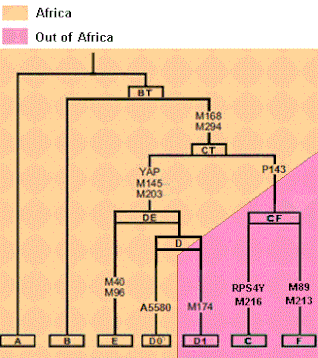This page is based on this
Wikipedia article Text is available under the
CC BY-SA 4.0 license; additional terms may apply.
Images, videos and audio are available under their respective licenses.
Haplogroup K is a human mitochondrial DNA (mtDNA) haplogroup. It is defined by the HVR1 mutations 16224C and 16311C.
Haplogroup J is a human mitochondrial DNA (mtDNA) haplogroup. The clade derives from the haplogroup JT, which also gave rise to haplogroup T. In his popular book The Seven Daughters of Eve, Bryan Sykes named the originator of this mtDNA haplogroup Jasmine. Within the field of medical genetics, certain polymorphisms specific to haplogroup J have been associated with Leber's hereditary optic neuropathy.
Haplogroup U is a human mitochondrial DNA haplogroup (mtDNA). The clade arose from haplogroup R, likely during the early Upper Paleolithic. Its various subclades are found widely distributed across Northern and Eastern Europe, Central, Western and South Asia, as well as North Africa, the Horn of Africa, and the Canary Islands.
Haplogroup A is a human Y-chromosome DNA haplogroup. It is the foundational haplogroup to all known patrilineal lineages carried by modern humans, and thus is the Y-chromosomal Adam.
Haplogroup JT is a human mitochondrial DNA (mtDNA) haplogroup.
In human mitochondrial genetics, haplogroup E is a human mitochondrial DNA (mtDNA) haplogroup typical for the Malay Archipelago. It is a subgroup of haplogroup M9.

In human mitochondrial genetics, Haplogroup Y is a human mitochondrial DNA (mtDNA) haplogroup.

In human mitochondrial genetics, haplogroup Q is a human mitochondrial DNA (mtDNA) haplogroup typical for Oceania. It is a subgroup of haplogroup M29'Q.
Haplogroup I-M438, also known as I2, is a human DNA Y-chromosome haplogroup, a subclade of Haplogroup I-M170. Haplogroup I-M438 originated some time around 26,000–31,000 BCE and has two primary subclades: I-L460, I-L596 and I-L147.
Haplogroup pre-JT is a human mitochondrial DNA haplogroup (mtDNA). It is also called R2'JT.

Haplogroup BT M91, also known as Haplogroup A1b2, is a Y-chromosome haplogroup. BT is a subclade of haplogroup A1b (P108) and a sibling of the haplogroup A1b1 (L419/PF712).
Haplogroup CF, also known as CF-P143 and CT(xDE), is a human Y-chromosome DNA haplogroup. This paternal lineage is defined by the SNP P143. The clade's existence and distribution are inferred from the fact that haplogroups descended from CF include most human male lineages in Eurasia, Oceania and The Americas.
Haplogroup H is a human mitochondrial DNA (mtDNA) haplogroup. The clade is believed to have originated in Southwest Asia, around 20,000 to 25,000 years ago. Mitochondrial haplogroup H is today predominantly found in Europe, and is believed to have evolved before the Last Glacial Maximum (LGM). It first expanded in the northern Near East and Southern Caucasus soon, and later migrations from Iberia suggest that the clade reached Europe before the Last Glacial Maximum. The haplogroup has also spread to parts of Africa, Siberia and inner Asia. Today, around 40% of all maternal lineages in Europe belong to haplogroup H.
Haplogroup R0 is a human mitochondrial DNA (mtDNA) haplogroup.
In human genetics, Haplogroup E-P147 is a human Y-chromosome DNA haplogroup. Haplogroup E-P147, along with the less common Haplogroup E-M75, is one of the two main branches of the older Haplogroup E-M96. The E-P147 clade is commonly observed throughout Africa and is divided into two subclades: the less common E-M33 & the more common E-P177.
Haplogroup GHIJK, defined by the SNPs M3658, F1329, PF2622, and YSC0001299, is a common Y-chromosome haplogroup. This macrohaplogroup and its subclades contain the vast majority of the world's existing male population.
Haplogroup S also known as S-B254 is a human Y-DNA haplogroup, defined by the SNPs B254 and Z33355. Until 2016, it was known as Haplogroup S1.
Haplogroup K2a is a human Y-chromosome DNA haplogroup. K2a is a primary subclade of haplogroup K2 (M526), which in turn is a primary descendant of haplogroup K (M9). Its sole primary descendant is haplogroup K-M2313.
Haplogroup A-P305 also known as A1 is a Human Y-chromosome DNA haplogroup. Like its parent haplogroup haplogroup A0-T (A-L1085), A1 includes the vast majority of living human males. It emerged in Africa approximately 161,300 years ago. By comparison, members of its sole sibling subclade, haplogroup A0 – the only other primary subclade of haplogroup A0-T – are found mostly in





